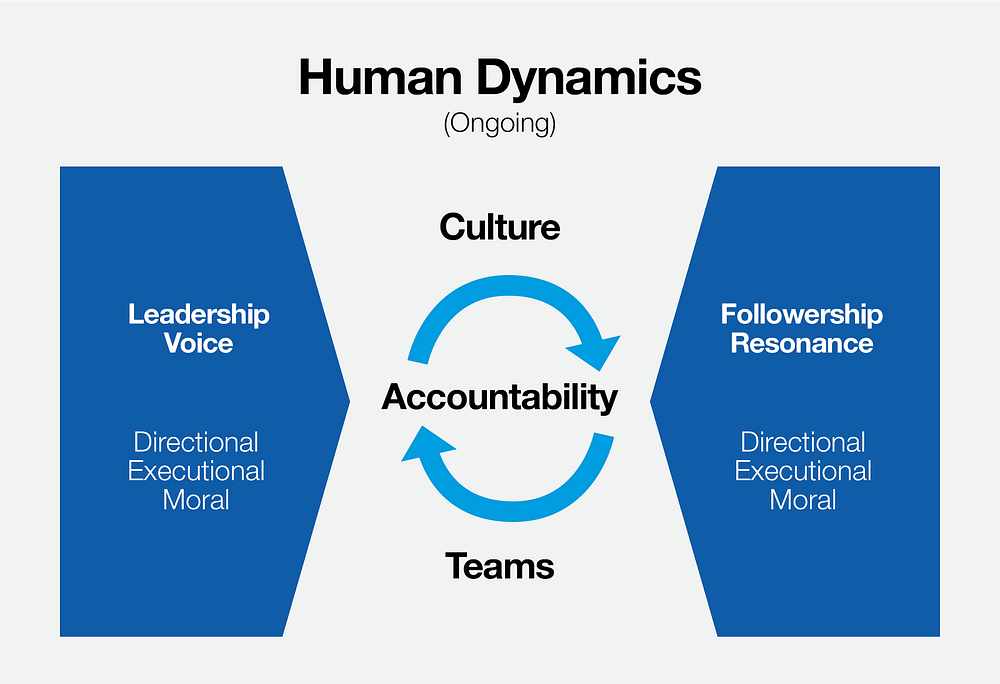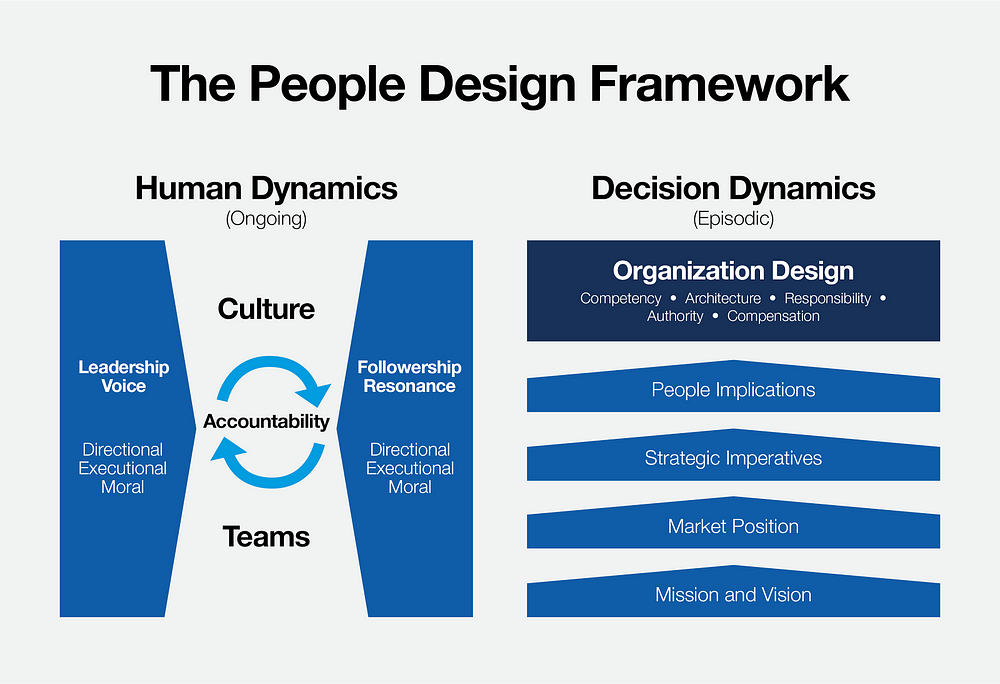If you are a tech company CEO, you know that the true value of your company resides in the hearts and minds of your people. It is their current output and future potential that inform the confidence of your investors and define the upper boundaries of company growth.
While this book’s primary focus is on tech company CEOs, the concepts presented are relevant for CEOs, senior executives, and mid-managers in any sector. Here you will find a new approach to leadership. Leadership is about unleashing human talent to accomplish great things. It’s about leverage. It involves not only decisions about people but also the way you interact with people. As such, in this book, we explore a People Design Framework made up of two parts — decision dynamics and human dynamics.
Designing an effective organization is complex. To select the right competency given a strategy, to accurately define roles and hierarchy, to determine staffing levels, to assign responsibility, to delegate authority, and to compensate appropriately are not small feats. When executed well, you achieve an organization design aligned with the task at hand. This process is called decision dynamics.
To create such an organization design, you must consider first your mission and vision, and second, compare both to your current market position. Third, you identify the key strategic imperatives that matter now and fourth, you consider any people implications. These steps prepare you to evaluate and update your organization design — to identify the competencies, architecture, responsibility assignments, delegations of authority, and compensation structures needed to take your company to the next level. Reorganizations large and small are in the domain of decision dynamics. Decision dynamics are episodic.
The second part of the people design framework is human dynamics. Human dynamics are ongoing. They unfold in the interplay between leaders and followers. In this exchange, the strength of a leader is revealed. In human dynamics, a leader gains leverage through voice in three areas:
- Directional voice
- Executional voice
- Moral voice
As leaders project directional, executional, and moral voice, followers judge whether the leader’s words and deeds resonate. In the shared accountability relationship between superior and subordinate, in the culture, and in the daily work of work groups and teams, leaders and followers engage in human dynamics.
Inside a company, the quality of leadership voice is keenly observed. The mission, strategy, and key initiatives are clear to all — or not. The company culture is actively cultivated and healthy — or not. Leaders lead with integrity and a continuous desire to improve themselves — or not. The relationship between superior and subordinate is managed carefully to optimize business impact and human development — or not. Leaders are transparent — or not. Power moves to the lowest possible level in the company — or not. Teams are chartered and run efficiently, exhibiting high levels of shared accountability — or not.
Followers anoint managers leaders when they observe strong directional, executional, and moral voice in action. As CEO, your daily acts of courage and selflessness — or your acts of betrayal, deception, and expediency — hone the culture of your company and impact the performance of your teams. These acts determine whether your employees are willing to make the sacrifice to call themselves followers and to call you their leader. These are human dynamics.
Take a look around. The business success of tech companies is wildly uneven. For every unicorn, there are thousands of companies who were well-funded but stalled out. What people failures sealed their fate? Now, look at those businesses that have achieved outsized financial success. With most, we find strong leadership, active followership, healthy culture, and vibrant work groups and teams. But even here there are cautionary tales. Even amongst the winners, we see examples of hard-won accomplishments put at grave risk by failures of directional, executional, or moral leadership.
This book covers both organization design (decision dynamics) and organization life (human dynamics). Throughout this book, we explore each component of decision dynamics and human dynamics. You will find many practical tools and techniques for building robust teams, nurturing a vibrant culture, and exercising the kind of leadership that creates followership.
Regarding human dynamics, some things are more important than others. Effective executional leadership is a “must have.” So is directional leadership — because if you don’t know where you’re going, any path will get you there. These two vectors of leadership are foundational. But worthy of special mention is the moral voice of leadership. Directional and executional voice are transactional. Moral voice is transformational. Inspired followership springs from steadfast moral voice.
We don’t see the moral voice of leadership discussed much these days. We should. The word “moral” comes from the Latin “moralitas.” It means “manner, character, and proper behavior.” Moral principles are universal — they exist at the heart of religion and philosophy in every corner of the world. Moral voice is the projection of a leader’s character into the organization she leads. A leader’s moral voice touches all the people she serves (customers, vendors, investors, and employees).
Consider the history of computer technology innovation — its stories and myths. If you look closely, you’ll notice that the moral dimension of leadership seems startlingly absent. There is much made about the solitary product vision of inspired CEOs, the on-the-edge drama of fundraising, coding death marches against intractable deadlines, the soaring thrills of suddenly viral customer adoption, and the vast accumulations of wealth that result. But a leader’s moral voice and its impact? Not so much.
Experiences at Uber and elsewhere clearly testify that this is a gap in desperate need of correction. Leaders outside of the tech sector understand this. Research by Sunny Giles published in the Harvard Business Review showed that global leaders rank ethics as the most important of all leadership competencies:¹
This research demonstrates that directional, executional, and moral voice are all critical to leadership.
In this book, you will find the story of a startup — “SparkLight Digital,” a fictitious company. You are the CEO. As the curtain opens in Chapter 1, SparkLight Digital is thirteen months old and teetering on the edge of annihilation. Chapter by chapter, you’ll watch your company lurch forward from crisis to crisis, step by staggering step along a ragged scaling path. On the journey, you will make a myriad of people design decisions. Each will shape your company’s direction. Each will shape you as a leader. Each will shape your followers, too — and your culture, and the performance of your work groups and teams. For better and for worse.
In the final chapter, you’ll join your top crew as you stand at the podium of NYSE. As you ring the bell and sweat out that first thirty minutes of trading — waiting for the market to place a value on your life’s work — you’ll reflect on all of your past decisions and the people that brought you here. You’ll remember your mistakes as well as your moments of courage. You’ll look around you, joining eyes briefly with each of your colleagues. Your smile will say thanks.
As the story unfolds, so too does the People Design framework — concept by concept, chapter by chapter. Sparklight Digital’s growth is tracked by the number of desks — from one to 500 — shown in each chapter’s title. Since so much of people design is stage-of-company specific, it feels right to roll out the framework concepts in a loosely stage-relevant way. By the end of the book, all the significant aspects of people design will rest in your hands.
Here are the chapters:
- One Desk — On Human Dynamics
- Three Desks — On Leadership Virtues
- Five Desks — On Being a Role Model
- Twenty Desks — On Directional Voice
- Seven Desks — On Accountability
- Eight Desks — On Teams
- Twelve Desks — On Culture
- Fifteen Desks — On Followership
- Twenty-five Desks — On Decision Dynamics
- Forty Desks — On Competency
- Forty-five Desks — On Organization Architecture
- One hundred Desks — On Responsibility and Authority
- Seventy Desks — On Compensation
- Eighty-five Desks — On How to Make Decisions
- Ninety-five Desks — On Communications Architecture
- One-hundred Twenty Desks — On Recruiting, Hiring, and Promoting
- One-hundred Fifty Desks — On Managing Workflow Groups
- Two-hundred Desks — On Headquarters vs. Remote
- Two-hundred Eighty Desks — On Horizontal vs. Vertical
- Three-hundred Thirty Desks — On Integrating Acquisitions
- Two-hundred Ninety-seven Desks — On Layoffs
- Three-hundred Fifty Desks — On Leadership Development
- Five-hundred Desks — On Succession Planning
An Appendix follows with Diagnostic Tools tied to the content in the book.
In writing the journey of SparkLight Digital, I drew upon two sources: my direct entrepreneurial experiences and observations in my role as founder and CEO of CEO Quest. As to the first, I chose to place SparkLight Digital inside the automotive industry as a company that provides marketing automation software for auto dealers because I know that space well enough to write convincingly about it. The tech startup I co-founded and built up over six years, Digital Air Strike, was (and is) in the auto space and does provide marketing automation software solutions. But the similarities end there.
As to the second, my experience leading CEO Quest has directly informed the many leadership dilemmas, influential incidents, and fork-in-the-road decisions found in this book. It is my distinct privilege to serve the member CEOs of CEO Quest. Every day inside these companies, the human drama of leadership and followership, culture and teams, conflict and collaboration, and shared accountability relationships plays out. Over time in my experience as a coach, an ample reservoir of fascinating stories has emerged. I’ve drawn liberally upon them in creating the narrative of SparkLight Digital — with adjustments to ensure anonymity.
. . .
Notes:
- Sunny Giles, “The Most Important Leadership Competencies, According to Leaders Around the World,” Harvard Business Review, March 15, 2016, https://hbr.org/2016/03/the-most-important-leadership-competencies-according-to-leaders-around-the-world.





